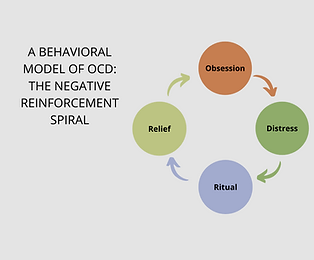
Effective Treatment for OCD
.png)
Exposure with Response Prevention (ERP)
Exposure with Response Prevention (ERP) is grounded in the Behavioral Therapy theories of fear and avoidance. Behavioral Therapy views psychological disorders as learned or conditioned behaviors that can be unlearned and changed through behavioral modification. ERP’s roots go back to the 1950s when exposures were generally applied to treating phobias and other anxiety-related symptoms. ERP is considered a type of CBT as it aims to modify behavior, and in doing so the individual has a change in their thinking (cognitions) about the feared stimulus. Due to its conception as a behavioral approach, ERP targets behaviors in treatment.
After showing effectiveness in treating phobias, ERP was applied to treating OCD, as people suffering from OCD experience anxiety responses to their obsessions and engage in compulsions. The idea is that if someone does anything to reduce their anxiety (compulsions) or avoids scary situations, thoughts, or feelings, they could be reinforcing their fears and making OCD’s narrative stronger and more scary. ERP aims to teach individuals that they can handle the scary responses, do nothing about them, and learn that they can be OK. This helps the person learn that they are safe, even if OCD says they might not be.
Inference-based Cognitive Behavioral Therapy (I-CBT)
Inference-Based Cognitive-Behavioral Therapy (I-CBT) is grounded in the Inference Based Approach (IBA) to OCD, which emphasizes the role of reasoning in the development and maintenance of OCD. Unlike “traditional” CBT, which states that obsessions are the product of maladaptive interpretations of intrusions, IBA argues that obsessions are part of unique doubting narratives and characteristic of confusion between reality and imagination or possibility. Building on the IBA foundation, I-CBT sees the start of OCD as an obsessional doubt that has occurred due to inferential confusion. I-CBT is thus unique among OCD treatments in that it not only conceptualizes OCD differently, but it does not require exposure to feared stimuli.
I-CBT aims to help clients resolve their inferential confusion by targeting the reasoning process and therefore resolving the obsessional doubt. By strengthening trust in reality, it empowers the client to move beyond fear and achieve change. I-CBT has the ability to get remarkably close to the source problem in OCD. If treatment is successful, the client no longer experiences the obsessional doubt or OCD triggers, and will have no need to avoid or do compulsions.
There are more than 40 published empirical studies on I-CBT, including two randomized controlled trials. These studies have shown that I-CBT is an effective treatment for OCD. Additionally, I-CBT has been shown effective at treating OCD for people who have not had success with other treatments, such as ERP.
.png)
